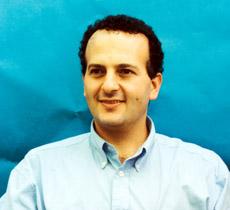Professor Kimia's research is in the Artificial Intellegence subfields of Computer Vision and Medical Image Understanding. His research aims at multiview reconstruction of scenes, parallel graph-based similarity search, developing BlindFind, a navigation device for the visually impaired, image-guided tumor ablation, and imaging for minimally invasive surgery.
Professor Kimia's research interests are in the areas of computer vision, image processing, medical imaging, perception, and psychophysics. A focus of his program is the problem of object recognition from shape. Free-form shape is represented by the geometry of its skeletal structure and the dynamics of flow of singularities along it-together referred to as the shock set. A natural grouping of shocks gives rise to a hierarchy represented as a graph, thus translating the recognition problem into graph matching. Notions of edit-distance in the shape space, categorization of shapes into classes, and their representation by a prototype or exemplar play a key role in successful indexing by shape into large image databases. Medical imaging is another focus of this research program. Three-dimensional datasets from computerized tomography (CT), magnetic resonance (MR) and other modalities are analyzed to extract relevant medical structure (segmentation), to register images over different scans, different modalities, and different patients (registration), for treatment follow-up, to create computational atlases, etc. The visualization and measurement of these structures can provide key clinical information to the physician. The generalization of the 2D shape representation to 3D is significant in applications requiring a notion of surfaces and volumes. We have classified the local forms of the 3D shock set, and the central skeletal sheets representing object symmetry. The mathematical classification of the transitions of the shock set order deformation is now established [Giblin-Kimia] in 2D but is open in 3D. Shape is completely reconstructable from its shock set, leading to a growth model of shape. We have built a language and a framework for creating and editing 2D free form and are now exploring its extension to the design of 3D form objects. Digital color halftoning is the problem of arranging colored dots, as produced by a modern printer (laser, inkjet, thermal, etc.) such that the perceptual effect is that of a continuous tone image, e.g., a photograph. This project involves the use of mathematical techniques in image processing, an understanding of the industrial use of color, and an examination of the perception of halftones.
P.J. Giblin and B.B. Kimia, "On the Local Form and Transitions of Symmetry Sets, and Medial Axes, and Shocks in 2D," Technical Report LEMS-170, LEMS, Brown University (1998).
K. Siddiqi, K.J. Tresness, and B.B. Kimia, "Parts of Visual Form: Ecological and Psycho-Physical Aspects," Perception, 25:399-424 (1996).
B.B. Kimia, A.R. Tannenbaum, and S.W. Zucker, "Shapes, Shocks, and Deformations, I: The Components of Shape and the Reaction-Diffusion Space," IJCV, 15:189-224 (1995).

